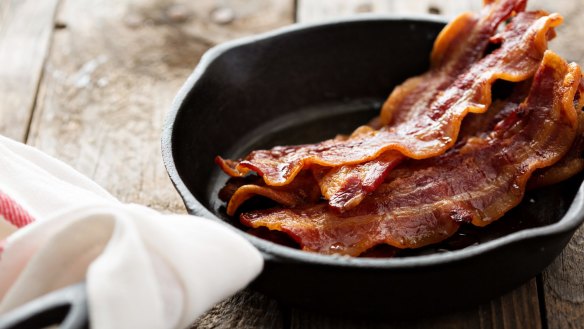What is the best way of cooking bacon?

What is the best way of cooking bacon? L. Hughes
The way you like it. I worked in a pub in Scotland where the bacon was deep fried before being placed in a floury bap, scantily smeared in pale, almost translucent margarine. The patrons, who enjoyed industrial quantities of vodka and Irn Bru (an orange-coloured sickly sweet soft drink flavoured with ammonium ferric citrate, making it taste like rusty fence), loved it. I recently discovered the joys of cooking bacon between two sheets of baking paper in a sandwich maker. Flat, golden brown and crisp. A good mate who used to own a guest house popular with Australia's best chefs lays strips of bacon on a baking tray and cooks them at 140C for 30 minutes until the rashers are crisp. With fat rendered out, he then adds whole cherry tomatoes and cooks them in the fat alongside the bacon for a further 15 minutes. Served with bubble and squeal (this is bubble and squeak made with ham hock), it is sensational. Alternatively, bacon slow-cooked in a heavy-based pan until crisp is good. Hint: Bacon fat is a delicious way to start browning off beef or lamb in slow-cooked meat dishes.
What is all-purpose flour? P. Caruthers
Locked in and locked down sees many of us Googling recipes from American websites. What you notice about American recipes is the use of cup and spoon measures. Be very careful using American measures as they differ slightly from Australian standard measures. The biggest difference is the tablespoon. Australia is one of the few nations on the globe to have a tablespoon that measures 20ml of liquid. The rest of the world uses 15ml. An American cup is 236ml or one quart of a "quart" or quarter of a gallon, while an Australian cup is 250ml or a quarter of a litre. Now, all-purpose flour is a blend of high- and medium-protein flour. Here in Australia we generally substitute all-purpose flour for plain flour, but astute bakers will choose specific flours for specific recipes. For cakes and biscuits, you want a flour with a lower percentage of protein, about 8 per cent. At the same time, bread making requires flour with higher protein content, about 12 per cent. I look for a West Australian brand called Lighthouse that produces a range of flours for cakes, steamed buns, tortillas, pizza and bread. I do like the Wallaby brand of flour for bread making. For day-to-day purposes, plain flour will produce good cakes and pancakes.
Letters
Recently we discussed stopping blueberries and other fruit from dropping to the bottom of muffins and cakes. D. Finn refers to the late TV scientist Julius Sumner Miller and suggests that fruit can be evenly distributed throughout a fruit cake "by adding the fruit to the creamed butter and sugar". "Make sure (each piece of) fruit is coated with the mixture before adding the dry ingredients. I have followed and taught this method ever since with 100 per cent good results. (I am giving away my age a bit!)."
Send your vexing culinary conundrums to brainfood@richardcornish.com.au or tweet to @realbrainfood.
Appears in these collections
- More:
- Food
- Brain food
